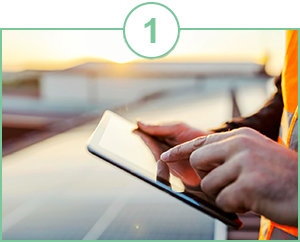Considering Solar
Reduce your carbon footprint, lower your electricity bill and
support California’s clean energy goals.

Why Go Solar?
By investing in a renewable system for your home or business, you can feel good about reducing your carbon footprint and contributing to a more sustainable future for all.
When you generate your own energy, you will likely buy less from the grid. Depending on your usage, this could reduce your bill. You can even earn bill credits for any excess energy you generate. Bill credits can be used to offset costs when you use more electricity than you generate.
If you’re considering solar, we’re here to help you learn about your different options and offer a step-by-step process of how to get started.
Types of Solar Energy Systems
There are a few different types of solar energy systems available.
- Photovoltaic (PV): Converts the sun’s light particles into electricity. This type is the most common for residential rooftop solar.
- Solar Thermal Energy (STE): Converts the sun’s heat into electricity.
- Concentrated Solar Power (CSP): Generated through large-scale solar farms.
- Solar Water Heaters: Provides and circulates solar-heated water. This type is great for pool owners.

About Solar Plus Battery Storage
Battery storage enables you to store energy generated by your solar panels. Benefits of battery storage include storing energy you generated during the day to be used at night and increasing your savings by exporting or selling power back to the grid.
The new modernized Solar Billing Plan incentivizes solar paired with battery storage to allow customers to use stored electricity or sell (export) excess electricity back to the grid during on-peak hours when prices are higher due to increased demand.
Available Solar and Battery Storage Credits and Incentives
Residential customers may qualify for a 30% federal tax credit through the Residential Clean Energy Credit.
The California Public Utilities Commission (CPUC) Self-Generation Incentive Program (SGIP) is currently offering Energy Storage rebates for homes, apartments and critical facilities.
The Disadvantaged Communities – Single-Family Solar Homes) DAC-SASH program, managed by Grid Alternatives, helps income-qualified homeowners in Disadvantaged Communities (DAC) receive no-cost rooftop solar installations.
The San Diego Solar Equity Program (SDSEP) offers monetary assistance to income-qualifying, single-family homeowners in the City of San Diego to offset the cost of solar panel installation.

Get Informed
Start by reading the California Solar Consumer Protection Guide. This guide takes you through every step of the solar installation process, provides tips to select a qualified solar provider, and outlines your rights as a consumer.
Did you know that your solar provider is required to collect your signature on the Solar Consumer Protection Guide before submitting your interconnection application?
View Guide

Make Your Home More Energy Efficient
Before you install solar, try to make your home more energy efficient. If you can reduce your energy use, you may be able to reduce the size of the solar system you need, potentially saving you thousands of dollars in installation costs.
Visit Savings Tips for Your Home for ways to save on energy. You may also want to consider participating in a residential demand response program.

Select a Contractor
A qualified, licensed solar contractor will provide you with a free home evaluation and comprehensive quote. Try to obtain and compare multiple bids before selecting a contractor.
Search for active solar contractors in your area using the California DG Stats search tool.

Get Approved for Installation
Your solar generating system needs to be installed, permitted and approved for interconnection. Your city or county will perform an onsite inspection and provide the required permit(s). SDG&E will provide authorization to operate/interconnect the solar system once proper installation and permitting are completed. SDG&E authorization is called “Permission to Operate,” or PTO, meaning you’ve been authorized to activate your renewable energy system on a specific date.
Solar system and installation costs vary according to size, location and contractor. You can use the California Solar Initiative’s Solar Calculator to estimate your costs and get a system size recommendation. You’ll also want to get quotes from multiple contractors. Your contractor can help you identify placement and decide which system you’ll ultimately install.
Incentives and rebates are available to make solar and renewable energy options more affordable. Explore your options and see if you qualify for financial support when you install or upgrade. Learn More about our solar credits and incentives.
SDG&E does not endorse or recommend specific contractors, but we do offer tips and resources to help you find a qualified contractor in your area. Search for active solar contractors in your area using the California DG Stats search tool.
Even if you invest in a solar system, you may not always have enough power for your home or business. For example, solar panels don’t generate electricity at night. During that time, you’ll need the grid to meet your energy needs. Being connected to the gird also allows you to export any excess energy generated by your system to the grid and earn generation credits that can be applied to your statement balance.
A quality renewable system, if properly installed, should provide you with approximately 25 years of self-generated energy. Since new technology develops rapidly, you may opt to update or upgrade your system over time. You’ll also want to properly maintain your system to maximize its lifespan.
For most standard rooftop solar systems, an annual inspection and cleaning by a qualified professional is sufficient to maintain your system and keep it operating at optimal capacity. Talk to your contractor about maintenance package options when you install.
Yes, Medical Baseline customers can have solar. If you use life-saving electrical medical equipment at home, you know that a reliable source of power is critical. That’s why it’s important to stay connected to the grid if you decide to install a solar or other renewable energy system. When the sun sets and your system isn’t producing electricity, you’ll always have energy flowing to keep your equipment running when you need it.
If you’re a renter or live in a home you don’t own, you may still be able to participate in renewable energy. Talk to your landlord about Virtual Net Metering (VNM).




